#rural-bengal
Explore tagged Tumblr posts
Text
Kuthi: A Vanishing Heritage of Rural Bengal
In the heart of rural Bengal, where life was once deeply rooted in the soil and its rhythms, the “kuthi” stood as a symbol of agricultural prosperity and sustainability. These simple, earthen granaries—made of mud, straw, and bamboo—were an integral part of the agrarian lifestyle, ensuring the safe storage of harvested grains. However, as time has marched forward, the kuthi has gradually faded…

View On WordPress
0 notes
Text



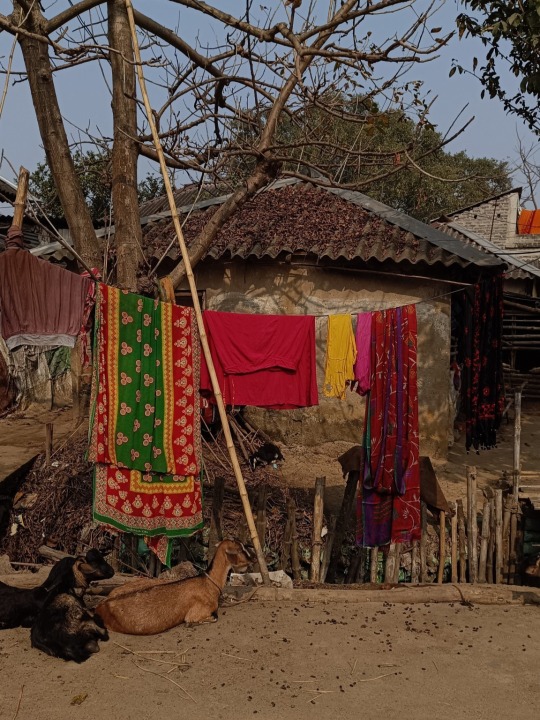
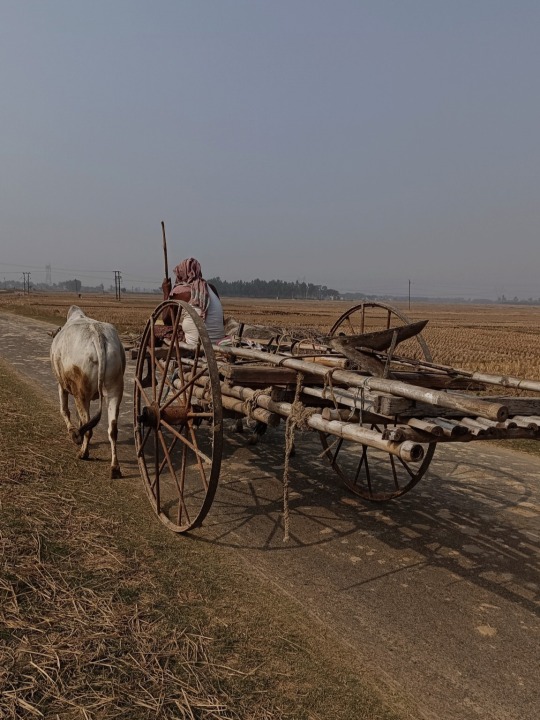

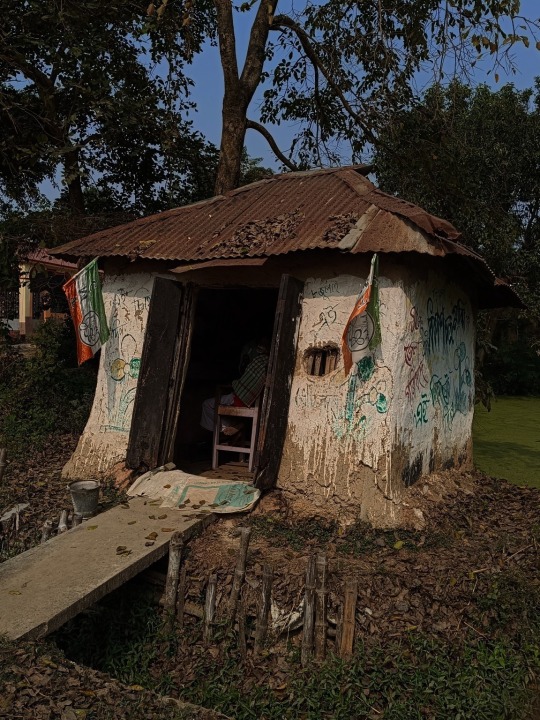
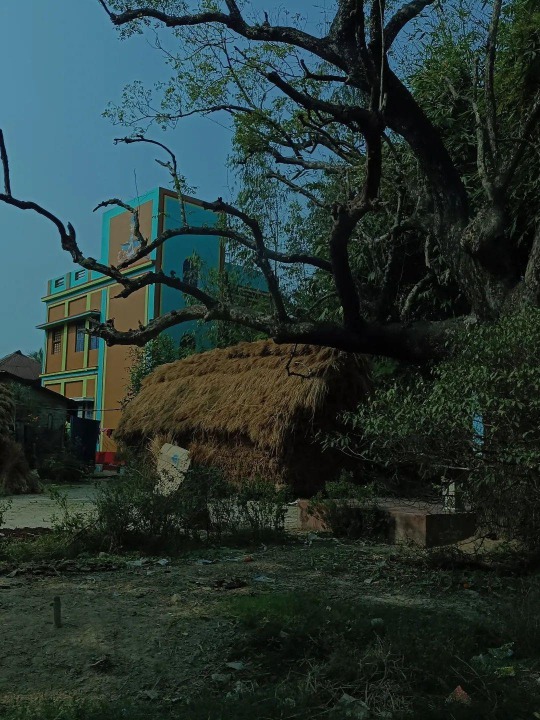


Photographs from my road trip across rural Bengal.
#everything was so golden! the soil the sunlight the hay etc. maybe because its that time of the harvest season#but i see why rabindranath wrote amar shonar bangla he wasnt being metaphorical#my photography#original photography#bangla tag#desi tag#desi aesthetic#desi tumblr#desiblr#south asia#south asian#india#west bengal#rural#rural architecture#street photography#nature photography#p
819 notes
·
View notes
Quote
No labour budget has been approved for West Bengal for 2023-24 under MGNREGS, keeping workers in a state of constant worry about their survival. Many have not received their wages due from 2021. Some have joined ongoing protests in New Delhi that began in February 2023, demanding their dues and rights for guaranteed work. MGNREGS, introduced in 2005, has served as a lifeline for rural workers whose livelihood entirely depend on it. Those registered can demand up to 100 days’ work with an average income of Rs 213 daily. The lack of funds have resulted in a food crisis for many in the state.
Himanshu Nitnaware, ‘Surviving on fish from gutter, rice: West Bengal workers bear brunt of Central freeze on MGNREGA funds’, Down To Earth
#Down To Earth#Himanshu Nitnaware#India#West Bengal#MGNREGS#unpaid wages#New Delhi#rural workers#food crisis
10 notes
·
View notes
Text
Tamarind Tree
Those were the impeccable times.
Thatched roof home, cow-dung veneered verandah stretched from the shallow pond to the phani manasa shrub.
Grandmother appearing. Two brinjals in hand. Two khadus on two wrists. Jingling. Ironly cuffs.
Said, "These are yours now — two young cows, you Badua! Take them to the grazing field. Protect them from Pashupati the bull. Collect dung in an iron pail.
We will not cut anymore this year a tamarind tree.
Only dry coconut shells, chaffs, cow dung cakes to boil cauldrons of paddy.”
The two brinjals were burnt the same night on the embers of a two-mouth chuli. Their violet skins peeled off, revealing mouth watering meat.
The same year, my grandmother peed on the verandah. On the mud it had made she slid, to break her forehead against her iron arm.
The vaidya prescribed a Chandrayan.
"Scant virtue, woman, too much phlegm! Yet, your silly heart beats!" He roared kindly.
Crooked lips — red eyes — three aunts circled in from their in-laws’ by noon —
At nightfall, we downed a tamarind tree.
Glossary:
Phani Manasa: Indian prickly pear tree, Opuntia ficus-indica. Khadus: Thick bangles. Badua: The head of a village (affectionately used). Chuli: An oven made by digging a hole in the ground. Vaidya: An ayurvedic doctor. Chandrayan: A Hindu ritual to wash off the sins of one who is soon to be deceased.
(The poem was first published in the Sahitya Akademi's ‘Indian Literature’ #326 in December, 2022)
#Poem#Potery#Childhood Memories#Fuel#Memories of My Grandmother#Poverty#Rural Bengal Life#Tamarind Tree#What burns and with what do you burn it?
2 notes
·
View notes
Text
youtube
In India, the West Bengal rural rave scene sees DJs set up DIY sound systems to disturb the peace
In India’s rural villages, 100 miles north of Kolkata, vast DIY sound systems are constructed at the risk of police seizure as moonlighting DJs battle to disturb the peace at ear-piercing decibels.
In an underground music scene known as Dek Bass, music producers from across India travel between villages to instigate these rural raves, spending up to 500 hours building sound systems that continually face police shutdown after their completion.
0 notes
Text
Discover Bangladesh: A Comprehensive Travel Guide
A Brief History of Bangladesh Bangladesh, located in South Asia, has a rich history that dates back to ancient times. The region was known as Bengal and was a significant cultural and commercial hub. Over the centuries, it saw the rise and fall of several dynasties, including the Maurya, Gupta, and Pala empires. Colonial Period In the late 16th century, the region came under Mughal rule, which…
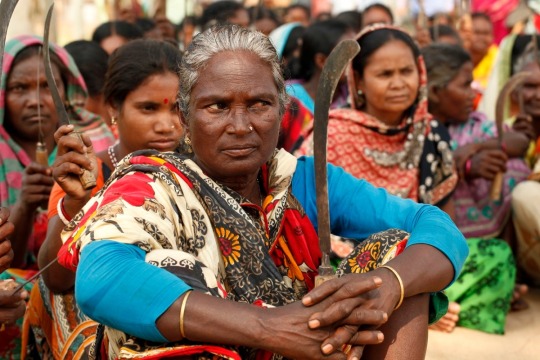
View On WordPress
#A Brief History of Bangladesh Bangladesh#adventure#africa#and a welcoming culture. Whether you&039;re exploring ancient ruins#and accommodation are inexpensive compared to many other countries#and Christianity. The country is known for its religious tolerance and cultural diversity. Food and Culture Bangladeshi cuisine is rich and#and domestic flights. 7. What should I wear in Bangladesh? Dress modestly#and major credit cards are accepted in urban areas#and modern trends#and Pala empires. Colonial Period In the late 16th century#and pitha (traditional cakes). The culture is a blend of ancient traditions#and the country is home to several reputable universities#and the Lawachara National Park. Rangamati: A scenic hill district known for its lakes#and the region became East Pakistan#Bangladesh achieved independence in 1971 following a brutal liberation war. Since then#breathable clothing is advisable due to the tropical climate. 8. Can I use credit cards in Bangladesh? Credit cards are accepted in major ci#Buddhism#but English is widely understood in urban areas and among the educated population. 6. What are the main transportation options within the co#but it&039;s wise to carry cash#but there are extensive bus and train networks for intercity travel. Religion The predominant religion in Bangladesh is Islam#colonial influences#dance#destinations#especially in cities#especially in rural areas and religious sites. Light#especially in rural regions. Conclusion Bangladesh is a vibrant and diverse destination with a rich history#europe#followed by Hinduism#Gupta#has a rich history that dates back to ancient times. The region was known as Bengal and was a significant cultural and commercial hub. Over
1 note
·
View note
Text
Tractors Available for Rent in West Bengal
Krishi Vikas Udyog is a leading provider of agricultural solutions in West Bengal. One of the many services they offer is Tractors Available for Rent in West Bengal. Renting a tractor can be a cost-effective solution for farmers who need equipment for a shorter period of time. Krishi Vikas Udyog offers a wide range of Tractors Available for Rent in West Bengal, including models from top manufacturers.
Their Tractors Available for Rent in West Bengal are well-maintained and in excellent working condition, ensuring that farmers can complete their farming operations efficiently. With flexible rental terms, farmers can choose the rental period that best suits their needs, whether it's a day, a week or several months.
Krishi Vikas Udyog is known for its exceptional customer service and reliable equipment. They have a good reputation in the community and are a trusted provider of agricultural solutions in West Bengal. If you're looking for Tractors Available for Rent in West Bengal, consider contacting Krishi Vikas Udyog for a quote. Their team of experts will help you choose the right equipment for your specific requirements, ensuring that you can complete your farming operations efficiently and effectively.
#tractors available for rent in west bengal#harvesters available for rent in west bengal#tractors for sale#tractors on rent#tractor#oldtractor#buytractor#agriculture#farming#rural
1 note
·
View note
Text
Polish neonazi who has spent their entire life in Canada and has never set foot on Polish soil: We Poles are just so glad that the evil Soviet Union is gone now so we can venerate our national hero, Władysław the Jew Smiter, without censorship.
Ordinary Polish guy: Idk man it kinda sucks that western financial firms came in and bought all our national industry and our social services are shit now and the picture of "upward mobility" offered to us is going to the UK and picking tomatoes in rural Kent while the inbred grandniece of the architect of the Bengal Famine films herself cracking a whip over our heads for her #girlboss motivational instagram account, and the main outlet for that frustration is catholic christofascism. Maybe it wasn't so bad before the fall of the SU (all of this is in polish so anglophones can't understand it and don't care to translate it)
smug liberal whitey, to me: Don't you hysterical darkies see? ex-soviet people are Glad the soviet union is gone! Look at what all polish people are saying, which in the english language is entirely sentiment one and not sentiment 2!
488 notes
·
View notes
Text
#FishFriday 🐟:

Kaligat painting of a fish and a crustacean (cataloged as “A Lobster and a Fish”) by an unknown Indian artist, 19th c.? gouache on paper, H 28 x W 45 cm Wellcome Collection 583056i, via Art UK
“Kalighat painting is a school of painting in Kalighat, a small district in Calcutta. It is named after the celebrated Hindu goddess Kali. Kalighat painting originated from the folk art tradition of rural Bengal. The Patuas or picture makers had migrated from Bengal in the early nineteenth century. There are a range of subjects, from religious imagery of Hindu gods, goddesses and stories to natural history, social types and proverbs. The range of materials used in drawings are pencil, watercolour, Indian ink and silver paint.”
#animals in art#painting#Kaligat painting#Indian art#South Asian art#Asian art#fish#crustacean#Wellcome Collection#19th century art#watercolor#pair#Fish Friday#Art UK
30 notes
·
View notes
Text
A walk through Bengal's architecture
Bengali architecture has a long and rich history, fusing indigenous elements from the Indian subcontinent with influences from other areas of the world. Present-day Bengal architecture includes the nation of Bangladesh as well as the Indian states of West Bengal, Tripura, and Assam's Barak Valley. West Bengal’s architecture is an amalgamation of ancient urban architecture, religious architecture, rural vernacular architecture, colonial townhouses and country houses, and modern urban styles. Bengal architecture is the architecture of Wind, Water, and Clay. The Pala Empire (750–1120), which was founded in Bengal and was the final Buddhist imperial force on the Indian subcontinent, saw the apex of ancient Bengali architecture. The majority of donations went to Buddhist stupas, temples, and viharas. Southeast Asian and Tibetan architecture was influenced by Pala architecture. The Grand Vihara of Somapura, which is now a UNESCO World Heritage Site, was the most well-known structure erected by the Pala rulers.

The Grand Vihara of Somapura
According to historians, the builders of Angkor Wat in Cambodia may have taken inspiration from Somapura. Bengal architecture became known for its use of terracotta due to the scarcity of stone in the area. Clay from the Bengal Delta was used to make bricks.
The temple architecture has distinct features like the rich wall decoration, often known as the terracotta temples, which was one of the remarkable elements of Bengali temple architecture. The double-roofed architecture of thatched huts was replicated by Bengali temples. Square platforms were used to construct the temples. Burnt brick panels with figures in geometric patterns or substantial sculptural compositions served as the temples' adornment.

Dochala style
These served as models for many temples that were built in undivided Bengal. Construction materials used in ancient times included wood and bamboo. Bengal has alluvial soil, so there isn't a lot of stone there. The bricks that were utilized to build the architectural components were made from stone, wood, black salt, and granite. Bengal has two different types of temples: the Rekha type, which is smooth or ridged curvilinear, and the Bhadra form, which has horizontal tiers that gradually get smaller and is made up of the amalaka sila. Mughal architecture, including forts, havelis, gardens, caravanserais, hammams, and fountains, spread throughout the area during the Mughal era in Bengal. Mosques built by the Mughals in Bengal also took on a distinctive regional look. The two major centers of Mughal architecture were Dhaka and Murshidabad. The do-chala roof custom from North India was imitated by the Mughals.

Jorasako thakurbari
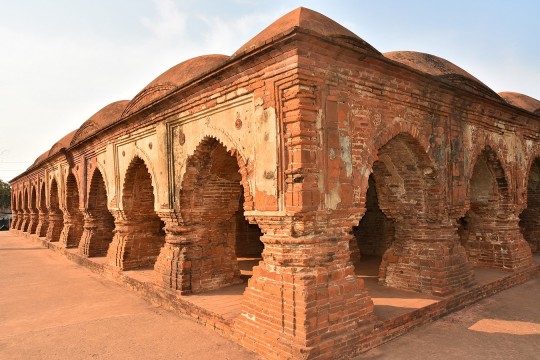
The Rasmancha is a heritage building located at Bishnupur, Bankura district, West Bengal.
Influence of the world on Bengal architecture: Although the Indo-Saracenic architectural style predominated in the area, Neo-Classical buildings from Europe were also present, particularly in or close to trading centers. While the majority of country estates had a stately country house, Calcutta, Dacca, Panam, and Chittagong all had extensive 19th and early 20th-century urban architecture that was equivalent to that of London, Sydney, or other British Empire towns. Calcutta experienced the onset of art deco in the 1930s. Indo-Saracenic architecture can be seen in Ahsan Manzil and Curzon Hall in Dhaka, Chittagong Court Building in Chittagong, and Hazarduari Palace in Murshidabad.
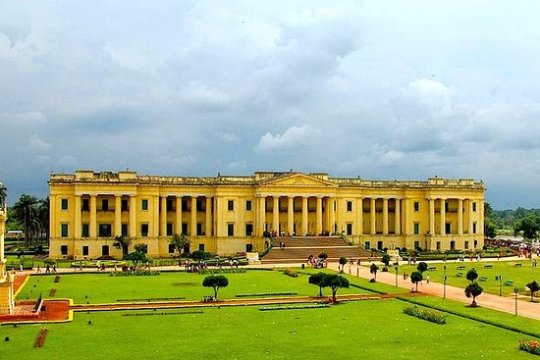
Hazarduari Palace in Murshidabad
The Victoria Memorial in Kolkata, designed by Vincent Esch also has Indo-Saracenic features, possibly inspired by the Taj Mahal. Additionally, Kolkata's bungalows, which are being demolished to make way for high-rise structures, have elements of art deco. The 1950s in Chittagong saw a continuation of Art Deco influences. The Bengali modernist movement, spearheaded by Muzharul Islam, was centered in East Pakistan. In the 1960s, many well-known international architects, such as Louis Kahn, Richard Neutra, Stanley Tigerman, Paul Rudolph, Robert Boughey, and Konstantinos Doxiadis, worked in the area.

The Jatiyo Sangshad Bhaban
This iconic piece of contemporary Bangladeshi architecture, was created by Louis Kahn. Midsized skyscrapers dominate the cityscapes of contemporary Bengali cities, which are frequently referred to as "concrete jungles." With well-known architects like Rafiq Azam, architecture services play a key role in the urban economies of the area. Overall Bengal architecture was influenced by various contemporaries of their time and continues to evolve.

Gothic architectural style seen in St. Paul's Cathedral in Kolkata.

Zamindar era buildings in ruin.

Belur Math in Howrah
#bengali#bangla#west bengal#bangladesh#tripura#assam#desi#বাংলা#india#architecture#tales#bengal architecture#history#kolkata#international#technology#information#temple#asia#bricks
192 notes
·
View notes
Text
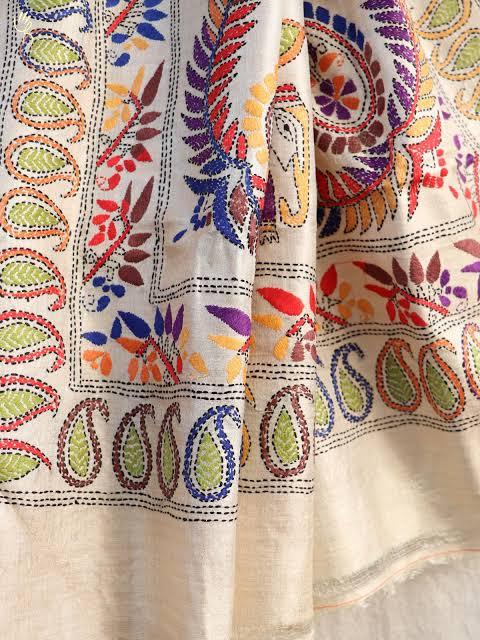
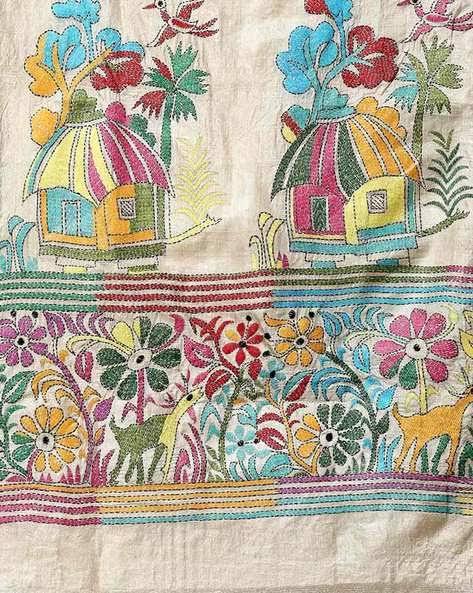
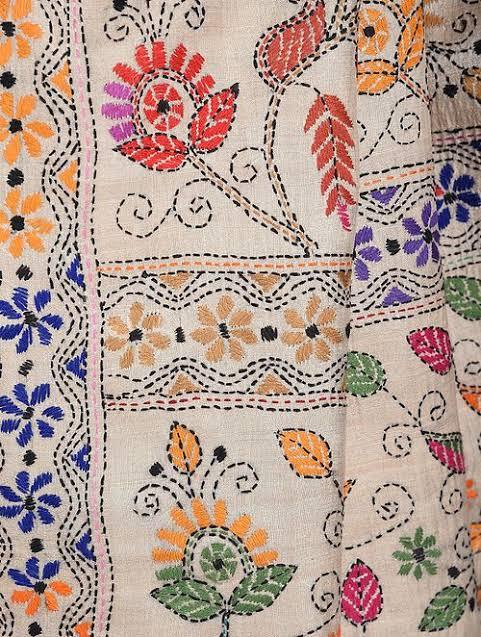
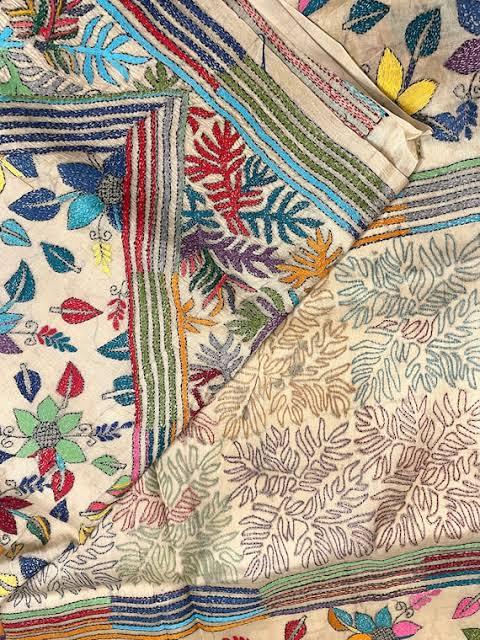

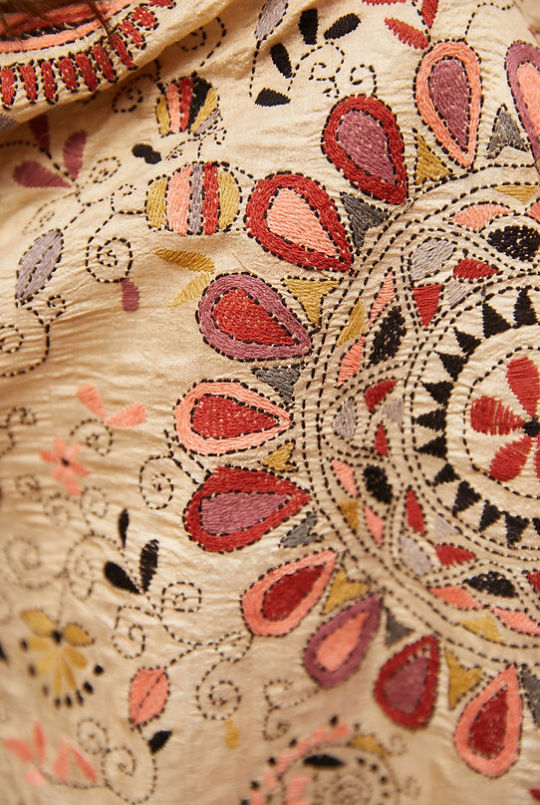
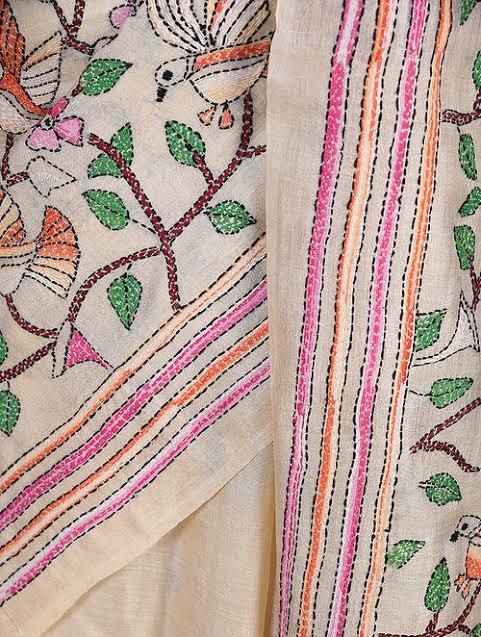
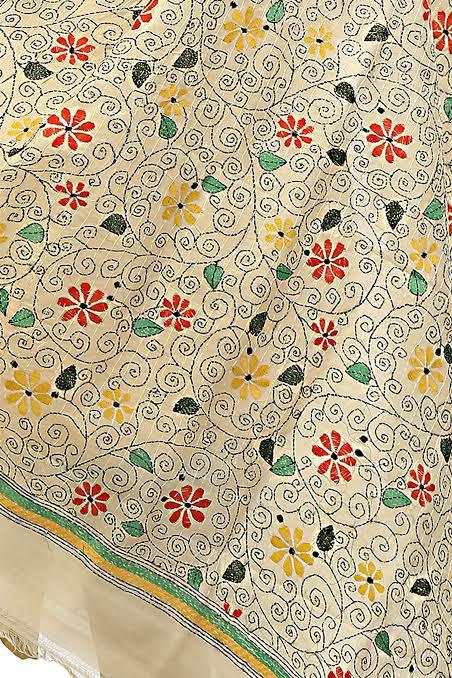

Kantha (Bengali: কাঁথা) is a form of embroidery originating in Bengal region, i.e. Bangladesh and the Indian states of West Bengal, Tripura and parts of Assam. It has its roots in nakshi kantha, an ancient practice among bengali women of making quilts from old saris and rags by sewing them together. In modern usage, kantha generally refers to the specific type of stitch used. The kantha needlework is distinct and recognised for its delicacy. The stitching on the cloth gives it a slightly wrinkled, wavy effect. Today, kantha embroidery can be found on all types of garments as well as household items like pillowcases, bags and cushions.
While it is an increasingly diversifying art form, traditional kantha embroidery motifs are still sought after. Traditional kantha embroidery is two-dimensional and are usually of two distinct types: geometric forms with a central focal point, carried over from the nakshi kantha tradition and influenced by islamic art forms; and more fluid plant, floral, animal and rural motifs with stick-figure humans depicting folklores and rural life in Bengal.
1 / 2 / 3 / 4 / 5 / 6 / 7 / 8 / 9 | textile series
#bangla tag#textiles#ots#kantha#nakshi kantha#bengal#bengali#bangladesh#india#embroidery#needlework#textile art#embroidery art#south asia#south asian
2K notes
·
View notes
Quote
As per the Act, the workers should get work as demanded, said activist Nikhil Dey. “Rural workers registered under the scheme are mandated to get work under Article 21 of the Constitution. The Article recognises the right to work as a fundamental right, which is being violated daily. These workers have the right to seek work for 100 days and earn a dignified income,” said Dey. The law also enables these workers to seek unemployment allowance and compensation for delayed wages for each passing day without work. “The central government is not following the rules, which is creating a crisis across the state and the country,” he added.
Himanshu Nitnaware, ‘Surviving on fish from gutter, rice: West Bengal workers bear brunt of Central freeze on MGNREGA funds’, Down To Earth
#Down To Earth#Himanshu Nitnaware#India#MGNREGA#Indian Constitution#Nikhil Dey#Rural workers#right to work#unemployment allowance#compensation for delayed wages#Government of India#West Bengal
3 notes
·
View notes
Text
Bride, 1970
A new bride has come, the palanquin has left. Those who’ve come late — the old viewers: grim. Brittle-finger mothers measure the skin of the girl. Her ornaments’ weight. Hair. Teeth. The onlookers grow. This new girl’s laugh — Tell me, tell me, ma, will she be tame?
Will she not blind our boy (for how long they themselves could)? But a new girl shall possess new new tricks! Carrying paddy from the paddy fields to the paddy pots, pots to the oven. Oven to the mill. The animals of the flower-bed night bathe the cattle, feed the cattle, smell of cow urine.
Love. Who calls its obtuse name? The clarinet calls. At the midnight play, Majnun bawls. The girl, too, weeps with him. Till her man appears. To bring her — to bed. Till the birds cackle, the sun appears. The girl wakes up to sweep the floor for another ten years. Now when the cowshed is clean, her daughter goes there to read.
(The poem was first published in the May 2023 issue of Poetry India: https://www.ethosliterary.org/poetry-india/may-2023-issue/poems-by-arun-paria)
#Poem#Poetry#Agrarian Life#Poverty & Education#Poverty & Love#Rural Bengal Life#Rural India#Rural South Bengal 1970#The Life of a Farmer Woman#Woman Marriage Emancipation
0 notes
Text









Glimpses of rural Bengal
(as haphazardly thrown together by yours truly)
7 notes
·
View notes
